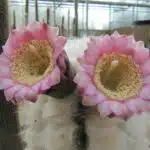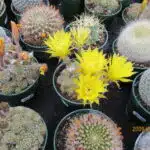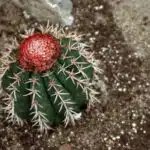The Powder Puff Cactus, also known as the Mammillaria Bocasana, is a unique indoor plant that requires care and attention to thrive. This cactus is native to Mexico and has become a popular addition to many households due to its striking appearance and easy-to-care-for nature. As a horticulturalist or plant care specialist, it is important to understand the growing needs of this particular species and provide necessary guidance for those who seek to cultivate it.
In this article, we will discuss the proper care and maintenance techniques required for the Powder Puff Cactus. We will explore topics such as light requirements, watering schedules, soil preferences, fertilization techniques, and common issues that may arise during the growing process. By following these guidelines, you can ensure that your Powder Puff Cactus thrives in its indoor environment, serving as an aesthetically pleasing addition to your home while also contributing to your overall well-being.
Understanding The Powder Puff Cactus
The Powder Puff Cactus is a cactus species that belongs to the Mammillaria genus, which consists of over 200 different types of cacti. This particular species is native to Mexico and is known for its unique characteristics. The plant’s scientific name is Mammillaria bocasana, and it gets its common name from the fluffy-looking white spines that cover its round green body.
One fascinating fact about this cactus species is that it can live for up to 30 years if properly taken care of. The Powder Puff Cactus has a slow growth rate, so it takes several years for the plant to mature fully. However, once it reaches maturity, it can produce beautiful pink flowers in the spring and summer months.
The unique characteristics of this cactus make it an excellent addition to any indoor garden or collection. Its small size makes it perfect for those with limited space, and its low-maintenance needs make it ideal for novice plant owners. Whether placed on a windowsill or among other plants on a shelf, the Powder Puff Cactus is sure to add charm and personality to any indoor space.
Moving onto the benefits of growing indoor plants, incorporating the Powder Puff Cactus into your home can have numerous advantages beyond just aesthetics.
The Benefits Of Growing Indoor Plants
Indoor plants provide numerous benefits that go beyond just their aesthetic appeal. The first advantage of indoor plants is their ability to improve air quality. Plants absorb carbon dioxide and release oxygen, which can positively impact the air in our homes. Moreover, certain indoor plants are known to remove toxins from the air, such as formaldehyde and benzene, making them a natural air purifier.
Another benefit of indoor gardening is space-saving. For those living in smaller houses or apartments, indoor gardening provides an opportunity to grow plants without taking up too much space. Furthermore, it allows people who live in urban areas with limited outdoor spaces to connect with nature and enjoy the benefits of growing plants at home.
Finally, indoor plants have been shown to provide stress relief and promote mental health. Research has found that simply being around plants can reduce stress levels and improve mood. Additionally, caring for plants can give individuals a sense of purpose and accomplishment, which can be beneficial for those struggling with mental health issues.
Moving on from the benefits of indoor gardening, let’s now discuss the light requirements for the powder puff cactus.
Light Requirements For The Powder Puff Cactus
What kind of light does the Powder Puff Cactus need to thrive? As a desert plant, it is accustomed to receiving plenty of sunlight. However, too much direct sunlight can be harmful and cause a sunburn. Therefore, it’s important to strike a balance between natural and artificial light sources.
When choosing the right location for your Powder Puff Cactus, consider the amount of light it receives throughout the day. Ideally, the cactus should receive at least six hours of indirect sunlight daily. If you’re unable to provide this amount of natural light, supplement with artificial light sources such as fluorescent or LED grow lights.
It’s worth noting that even though the Powder Puff Cactus thrives in sunny environments, it can also grow well in shady areas. In fact, shading during the hottest part of the day can protect against sun damage. Ultimately, finding the perfect location for your cactus will depend on various factors including your home’s layout and available light sources.
Watering Techniques For Optimal Growth
- When it comes to watering techniques for optimal growth, the frequency of watering and the soil moisture levels are key considerations.
- It is important to understand that the water requirements of the powder puff cactus depend on the soil it is planted in, the temperature of the environment, and the amount of light it receives.
- Typically, the powder puff cactus should be watered lightly, but frequently, as it does not like to be left in soil that is too wet for too long.
- An ideal soil moisture level for the powder puff cactus is one that is damp to the touch, but not soggy or overly wet.
- Fertilizer use should be kept to a minimum, as the powder puff cactus is a slow grower and does not require as much nutrient supplementation as other plants.
- When using fertilizer, it is important to use one that is specifically formulated for cacti, as it will contain the necessary micronutrients to support optimal growth.
Water Frequency
One of the most important aspects of caring for a powder puff cactus is getting the watering frequency right. Over or under-watering can have significant effects on the growth and overall health of this indoor plant. The ideal watering schedule will depend on several factors, including the size of the pot, soil type, and environmental conditions.
Overwatering can be particularly damaging to powder puff cacti. When these plants are watered too frequently, it can lead to root rot and other fungal diseases that can quickly kill them. On the other hand, underwatering can cause leaves to droop and fall off, which can stunt growth and even lead to death. As such, it’s crucial to strike a balance between over and under-watering when caring for your powder puff cactus.
To ensure optimal growth throughout the year, it’s also important to adjust your watering frequency based on seasonal changes. During winter months when indoor heating may dry out soil more quickly, you may need to water less frequently. Conversely, during summer months when temperatures rise and humidity levels increase, you may need to water more often than usual. By understanding how seasonal changes affect your powder puff cactus’ water needs, you can help ensure that it thrives year-round.
Soil Moisture Levels
When it comes to caring for a powder puff cactus, watering is one of the most crucial aspects that require attention. As mentioned earlier, over or under-watering can significantly affect its growth and overall health. However, determining the ideal watering schedule is not just about considering environmental factors but also measuring hydration levels in the soil.
Measuring hydration levels in the soil is an effective way to avoid overwatering your powder puff cactus. One method of doing this is by sticking your finger about an inch deep into the soil. If it feels dry, then it’s time to water your plant. On the other hand, if you feel moisture, it’s best to hold off on watering for a few more days.
Apart from measuring soil moisture levels by touch, you can also use a moisture meter that measures how much water is in the soil. These devices come with probes that you stick into the soil to get an accurate reading of soil moisture levels. By monitoring and adjusting watering frequency based on soil moisture levels rather than just following a strict schedule, you can ensure optimal growth and health for your powder puff cactus throughout its lifespan.
Fertilizer Use
Transition:
Aside from watering, another critical aspect to consider in caring for a powder puff cactus is the use of fertilizers. Proper fertilization can significantly affect the growth and overall health of your plant. In this subtopic, we will discuss the difference between organic and synthetic fertilizers and the ideal frequency of their application.
Organic vs. Synthetic Fertilizers:
When it comes to fertilizers, you have two primary options: organic or synthetic. Organic fertilizers are derived from natural sources such as animal waste, compost, and bone meal. These types of fertilizers release nutrients slowly and are less likely to burn your plant’s roots. Meanwhile, synthetic fertilizers are made from chemicals that provide quicker results but may have long-term effects on the soil’s health.
Frequency of Fertilization:
The frequency of fertilization depends on various factors such as the type of fertilizer used, soil condition, and environmental factors. Generally, it’s best to apply fertilizer during the growing season when your powder puff cactus requires more nutrients to support its growth. However, be careful not to over-fertilize your plant as it can cause root damage or even death. A good rule of thumb is to apply fertilizer once every four weeks during the growing season while reducing applications during winter months when your plant goes dormant.
Conclusion:
In summary, proper fertilization is crucial in ensuring optimal growth and health for your powder puff cactus. When selecting a fertilizer type, consider using organic options that release nutrients slowly and nourish both your plants and soil in the long run. Additionally, applying fertilizer once every four weeks during the growing season while reducing applications during winter months can help avoid over-fertilizing your plant while still providing essential nutrients necessary for its growth.
Soil Preferences For Healthy Roots
Choosing the right soil for your powder puff cactus is crucial to ensure healthy root growth. The ideal soil for this plant should be well-draining, as the powder puff cactus is susceptible to root rot if left in standing water. A mixture of sand, perlite, and peat moss can create a well-draining soil that also retains moisture to prevent the cactus from drying out.
Potting techniques are also important when it comes to promoting healthy root growth in your powder puff cactus. When repotting, carefully remove any old soil from the roots and gently loosen them before placing them in fresh soil. It is recommended to choose a pot that is only slightly larger than the current one, as excess space can lead to overwatering and hinder root development.
In addition to proper soil and potting techniques, it’s important to avoid compacting the soil around the roots too tightly. This can limit oxygen flow and make it difficult for roots to grow properly. Instead, gently pat down the soil while leaving some space for air pockets.
- The ideal soil for a powder puff cactus should be well-draining
- A mixture of sand, perlite, and peat moss can create a well-draining soil
- Choose a pot that is only slightly larger than the current one
Now that you know how to choose the right type of soil and pot your powder puff cactus correctly, let’s move on to fertilization methods that can help boost its growth.
Fertilization Methods To Boost Growth
Healthy soil is the foundation of healthy roots, which are essential for the growth and development of any plant. However, even with the best soil conditions, plants can still benefit from added nutrients that promote growth and overall health. This is where fertilization comes in.
When it comes to fertilization methods for your powder puff cactus, there are two main types: organic and synthetic. Organic fertilizers are derived from natural sources such as compost, manure, or bone meal, while synthetic fertilizers are chemically manufactured. While both types can provide necessary nutrients for your plant, many horticulturalists prefer organic options due to their sustainability and environmentally-friendly nature.
The timing of fertilization is also crucial for optimal growth. It’s important to avoid over-fertilizing your powder puff cactus as this can lead to root burn or other negative effects. Generally speaking, it’s best to fertilize during the active growing season (usually spring and summer) and reduce or eliminate fertilization during dormancy periods (usually fall and winter). By following these guidelines and choosing the right type of fertilizer for your plant’s needs, you can help ensure healthy growth and development.
Moving onto potting and repotting procedures…
Potting And Repotting Procedures
As with any indoor plant, it is essential to choose the right pot size when planting powder puff cactus. The ideal pot size will depend on the size of the plant, but as a rule of thumb, it should be around two inches larger in diameter than the current container. Choosing too large of a pot can lead to overwatering and root rot, while a container that is too small can stunt growth and restrict root development.
The frequency of repotting your powder puff cactus depends on how quickly it outgrows its current container. Generally, you should repot every one to two years or when you notice roots growing through the drainage holes. It is best to do this during the spring or summer months when the plant is actively growing. When repotting, gently remove the plant from its old container and remove any dead or damaged roots before placing it in a new pot with fresh soil.
When repotting your powder puff cactus, it is also an excellent opportunity to check for pests or signs of disease. Inspect both the roots and foliage for any issues and treat accordingly before placing it in its new home. With proper care and attention to detail during potting and repotting procedures, your powder puff cactus will thrive in its new home.
Moving forward into pruning and maintenance tips, there are several ways you can help keep your powder puff cactus healthy and vibrant.
Pruning And Maintenance Tips
Did you know that the powder puff cactus is a low-maintenance plant that needs minimal pruning? However, like any other indoor plant, it does require basic maintenance to keep it healthy and thriving. Pruning techniques are critical for maintaining the shape of the plant and removing dead or diseased parts.
To begin with, you should prune your powder puff cactus by using sterilized scissors or blades to prevent infections. Start by inspecting the plant for any yellow, brown or wilting leaves, which could be signs of disease or pest infestations. Cut off these affected parts, making sure to leave a small margin from the healthy tissue to avoid injuring the stem. Additionally, you can also trim off any branches that are growing in odd directions or causing overcrowding.
Apart from pruning, regular maintenance of your powder puff cactus will ensure its longevity and enhance its appearance. A maintenance schedule should include watering once a week during warm weather and reducing watering frequency during winter months when it goes into dormancy. Fertilize monthly with a balanced liquid fertilizer during growing season (spring – summer) and provide adequate sunlight exposure. If you notice any signs of pests such as spider mites or mealybugs on your powder puff cactus, take prompt action to eradicate them using natural remedies or commercially available insecticides.
With proper pruning techniques and regular maintenance schedules in place, your powder puff cactus will remain an attractive addition to your indoor garden for many years to come. In the subsequent section, we will explore propagation techniques for new plants from existing ones without breaking a sweat!
Propagation Techniques For New Plants
After properly maintaining and pruning your powder puff cactus, you may want to propagate it to share with friends or expand your collection. There are various propagation methods that you can choose from depending on your preference and availability of materials. Some of these methods include stem cuttings, leaf cuttings, and offsets.
Stem cuttings are the most common method used for powder puff cactus propagation. You can take a cutting from the stem during its active growth period, which is typically in the spring or summer. Ensure that the cutting has a few nodes and let it dry out for a day or two before planting it in well-draining soil. Leaf cuttings can also be taken during the active growth period by carefully removing healthy leaves from the plant and letting them dry out before placing them on top of soil.
Optimal timing is essential when propagating powder puff cactus plants. Stem cuttings should be taken during the active growth period while leaf cuttings can be taken at any time of the year as long as they are healthy. Offsets, which are small plantlets that grow from the base of mature plants, can be removed during repotting and replanted separately.
Propagation is an exciting part of caring for your powder puff cactus as it allows you to create new plants and share them with others. With different propagation methods available, you can experiment with what works best for you while simultaneously expanding your collection. In the next section, we will discuss common issues faced when growing powder puff cacti and how to solve them to ensure optimal plant health.
Common Issues And How To Solve Them
Discoloration of the powder puff cactus is typically caused by inadequate light exposure and can be resolved by increasing the amount of light in its environment. Fungal infections are often caused by excessive moisture and can be treated with specialized fungicides. Root rot is a serious condition of the powder puff cactus and can be prevented by ensuring that the soil is well-drained and avoiding overwatering. If root rot has already occurred, the affected roots should be removed and the remaining roots treated with a fungicide.
Discoloration
As a plant care specialist, it is important to understand the causes of discoloration in powder puff cacti. Discoloration can occur due to various reasons such as over or under watering, insufficient lighting, pest infestations, and nutrient deficiencies. Overwatering can lead to root rot which causes yellowing or browning of leaves while underwatering can cause shriveling and discoloration of the cactus. Insufficient lighting can result in pale or yellowish-colored leaves.
Prevention of discoloration in powder puff cacti involves maintaining proper watering and lighting schedules. It is crucial to ensure that the soil is well-drained, and excess water should be drained from the pot after watering. The plant should be given enough light exposure; approximately 6 hours per day for optimal growth. If pests are present, it is advisable to use natural pesticides such as neem oil instead of chemical-based ones as they may damage the plant further.
In conclusion, discoloration is a common problem experienced by plant owners when caring for powder puff cacti. However, with proper care and attention, this issue can be prevented. By providing ample watering and light exposure while also using natural remedies for pest control, your powder puff cactus will thrive and remain healthy for years to come.
Fungal Infections
Fungal infections are a common issue that can affect powder puff cacti. When left untreated, they can cause serious damage to the plant and even lead to death. Fungal infections often occur due to overwatering or poor drainage, which creates a damp environment for fungi to thrive in. Symptoms of a fungal infection include brown or black spots on the leaves, as well as yellowing or wilting.
Prevention measures for fungal infections include proper watering practices and ensuring adequate drainage. The soil should be well-draining, and excess water should be removed from the pot after watering. Additionally, it is important to avoid getting water on the leaves and stem of the plant as this can create a moist environment that encourages fungal growth. If you suspect your powder puff cactus has a fungal infection, isolate it from other plants and remove any infected parts immediately.
Treatment options for fungal infections in powder puff cacti include using an antifungal spray or solution. These products are readily available at most garden centers and nurseries. It is important to follow the instructions carefully when applying them to avoid damaging the plant further. In severe cases where the infection has spread throughout the entire plant, it may be necessary to repot the cactus in fresh soil and remove any infected roots. With timely intervention and appropriate treatment measures, your powder puff cactus can recover from a fungal infection and continue to thrive.
Root Rot
Another common issue that powder puff cacti face is root rot. Root rot occurs when the roots of the cactus are exposed to excess moisture and cannot properly absorb oxygen, leading to their decay. Symptoms of root rot include yellowing or wilting leaves, a soft and mushy stem, and a foul odor emanating from the soil.
Prevention measures for root rot involve proper watering practices and ensuring adequate drainage. The soil should be well-draining, with a mix of sand or perlite added to increase its porosity. It is also important to avoid overwatering the plant and allowing excess water to sit in the saucer beneath the pot. In addition, inspecting the roots regularly for any signs of decay can help catch early stages of root rot before it spreads throughout the entire plant.
Treatment options for root rot in powder puff cacti include removing any affected roots and repotting the cactus in fresh soil with proper drainage. Applying fungicides may also help prevent further spread of fungal infections that may contribute to root rot. However, prevention is key when it comes to addressing root rot in powder puff cacti as it can be difficult to treat once it has taken hold. By following proper watering practices and providing adequate drainage, you can ensure that your powder puff cactus stays healthy and free from root rot.
Pest Control Measures
Just like every garden has its pests, indoor plants have their own share of unwanted visitors. It is imperative to protect our beloved powder puff cactus from pests. A healthy and well-cared-for plant is more resistant to insects and diseases than a stressed or unhealthy one. As such, we should strive to provide the best possible growing conditions for our cactus.
Unfortunately, even with the best care, it’s still possible for pests to invade your plant. There are natural remedies that can be used as a first line of defense against common pests such as mealybugs and spider mites. One example is mixing water and dish soap in equal parts and spraying it on the affected areas. Alternatively, neem oil can be diluted in water and sprayed on the leaves.
If natural remedies do not work or if the infestation is severe, professional pest control services may be necessary. They have access to chemical treatments that are safe for both people and pets but deadly to insects. However, these treatments should only be used as a last resort as they can harm beneficial insects such as bees and ladybugs.
Pest control measures are essential in maintaining good plant health. By using natural remedies or seeking professional help when necessary, we can keep our powder puff cactus healthy and thriving. In the next section, we will discuss creating the ideal environment for your cactus so it can continue to flourish.
Creating The Ideal Environment For Your Cactus
To ensure that your powder puff cactus thrives, it is important to create an ideal environment in terms of temperature, humidity, and light. Firstly, it is essential to keep your cactus in a warm and dry place with temperatures ranging from 65°F to 85°F. When exposed to extreme cold or heat, the plant may become stressed and ultimately die. Therefore, avoid placing the cactus near windows or vents that can cause fluctuations in temperature.
Secondly, humidity plays a crucial role in the growth of powder puff cacti. They prefer low levels of humidity between 10-30%. However, if you live in an area with high humidity levels, it’s best to use a dehumidifier or air conditioner to regulate the moisture content. High humidity can lead to fungal infections, rotting roots and stunted growth.
Lastly, selecting the right pot and soil mixture is vital for ensuring optimal growth conditions for your cactus plant. Choose a well-draining pot with enough drainage holes as waterlogged soil can cause root rot leading to death of the plant. For soil mixtures, it’s recommended to use coarse sand mixed with perlite or pumice for adequate drainage.
Creating an ideal environment for your powder puff cactus will result in healthy foliage and stunning blooms. In the next section, we’ll discuss how decorating with these beautiful plants can add character and personality to any living space.
Decorating With Powder Puff Cacti
Using powder puff cacti in terrariums is a great way to add a touch of greenery to your indoor space. Terrariums are closed glass containers that can be filled with soil, rocks, and other decorative items. Powder puff cacti make excellent additions to terrariums because they thrive in environments with high humidity levels. When designing a terrarium, select plants that have similar lighting and watering needs to ensure their survival.
Incorporating powder puff cacti into bohemian decor can add an exotic touch to your living space. Bohemian decor is known for its relaxed, unconventional style that incorporates natural elements such as plants and woven textiles. The powder puff cactus fits perfectly into this aesthetic with its unique appearance and low-maintenance care requirements. Consider pairing the powder puff cactus with colorful textiles or vintage furniture pieces for a truly bohemian vibe.
When caring for powder puff cacti, it’s important to remember that they require minimal attention but still need proper care. To keep them thriving, provide ample sunlight and water them sparingly during the growing season. Additionally, avoid over-fertilizing the plant as this can lead to stunted growth or even death. For advanced care techniques for experienced gardeners, consider experimenting with grafting or propagation methods to create new varieties of powder puff cacti.
Advanced Care Techniques For Experienced Gardeners
Now that you have learned how to decorate with powder puff cacti, it’s time to delve into advanced care techniques for experienced gardeners. Proper care and attention will ensure that your powder puff cactus thrives and remains healthy for years to come.
Firstly, DIY propagation is a valuable technique for experienced gardeners who want to expand their collection of powder puff cacti. Propagation involves taking cuttings from the mother plant and rooting them in soil or water. This process requires patience and careful attention, but it is a rewarding experience when successful. Remember to keep the new plants in a warm and humid environment until they establish roots.
Secondly, unique containers are a great way to showcase your powder puff cactus while also providing optimal growing conditions. The container should be well-draining to prevent root rot, and it should be large enough for the plant’s growth. Consider using decorative pots made from terracotta, ceramic or even repurposed materials like old teapots or jars.
Lastly, experienced gardeners should pay close attention to their powder puff cactus’s watering schedule. These plants thrive in arid environments with infrequent watering intervals. Overwatering can lead to root rot and other problems, so it’s important to allow the soil to dry out completely between watering sessions.
As an experienced gardener, you have the skills necessary to take your powder puff cactus care routine to the next level. With DIY propagation techniques and unique containers, you can expand your collection while creating a beautiful display in your home or office space. Remember these advanced care techniques as you continue on your journey as a plant enthusiast.
Transitioning into the subsequent section about ‘conclusion: enjoying the beauty of your powder puff cactus’, it is important to note that proper care techniques will ultimately lead to a thriving and visually stunning plant for all to enjoy.
Conclusion: Enjoying The Beauty Of Your Powder Puff Cactus
One common misconception about powder puff cacti is that they are difficult to care for, but this couldn’t be further from the truth. With just a little bit of attention and care, these beautiful plants can thrive in any indoor setting. In fact, one of the best things about owning a powder puff cactus is how easy it is to enjoy their beauty without much maintenance.
To fully appreciate your powder puff cactus, consider incorporating some creative display ideas into your home decor. These plants look stunning when grouped together in different sizes and shapes of pots or containers. You could also try placing them on a windowsill or hanging them from a ceiling hook to add some height and interest to the space.
If you’re feeling crafty, there are also many DIY plant accessories you can make to enhance the look of your powder puff cactus. For example, you could create macrame hangers or paint terra-cotta pots with fun designs that complement your home’s aesthetic. By adding these personal touches, you can truly make your powder puff cactus a statement piece in your home.
| Common Problems | Causes | Solutions |
|---|---|---|
| Yellowing leaves | Overwatering or too much sun exposure | Reduce watering frequency and move plant to a shadier spot |
| Pests such as mealybugs or spider mites | Lack of humidity or poor air circulation | Increase humidity by misting leaves regularly and ensure proper ventilation |
| Stunted growth or lack of blooms | Insufficient light or nutrients | Move plant to a brighter area and fertilize regularly with a balanced fertilizer |
By following these tips for caring for your powder puff cactus and incorporating creative display ideas into your home decor, you can enjoy the beauty of this unique plant without much hassle. Remember that every plant owner encounters challenges along the way, but by identifying common problems early on and implementing effective solutions promptly, you can keep your powder puff cactus looking healthy and vibrant.
Conclusion
The Powder Puff Cactus is a unique and beautiful indoor plant that can add a touch of elegance to any room. Understanding the specific care requirements and preferences of this cactus is essential for ensuring its optimal growth and health. As an experienced gardener, it is important to recognize the various factors that can impact the growth of your Powder Puff Cactus, including light, water, soil, and environmental conditions.
When caring for your Powder Puff Cactus, it is essential to provide it with sufficient light to promote healthy growth. Additionally, watering your cactus correctly and using appropriate soil can help prevent over or under-watering and promote healthy root development. Creating an ideal environment that mimics its natural habitat can also aid in the longevity of this indoor plant.
As a horticulturalist or plant care specialist, you may want to decorate your space with Powder Puff Cacti by placing them in stylish pots or arranging them creatively on shelves or tables. Advanced care techniques such as pruning or propagation should only be attempted by experienced gardeners who have a thorough understanding of the needs of this unique species.
In conclusion, growing and caring for Powder Puff Cacti requires patience, attention to detail, and careful observation. By following the guidelines outlined above and monitoring your cactus regularly, you can ensure that it thrives in its indoor environment. With their beautiful blooms and unique appearance, Powder Puff Cacti are sure to become a treasured addition to any indoor garden collection.
Image Credits
- “Pink Puff Cactus Flowers in Mint & Cream 12.2” by Crystal Writer (featured)





























